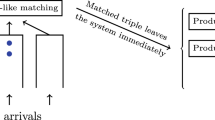Abstract
We explore M/G/∞ systems ‘fed’ by Poissonian inflows with infinite arrival rates. Three processes – corresponding to the system's state, workload, and queue-size – are studied and analyzed. Closed form formulae characterizing the system's stationary structure and correlation structure are derived. And, the issues of queue finiteness, workload summability, and Long Range Dependence are investigated.
We then turn to devise a ‘reverse engineering’ scheme for the design of the system's correlation structure. Namely: how to construct an M/G/∞ system with a pre-desired ‘target’ workload/queue auto-covariance function. The ‘reverse engineering’ scheme is applied to various examples, including ones with infinite queues and non-summable workloads.
Similar content being viewed by others
References
L. Takacs, Introduction to the Theory of Queues, Oxford University Press, 1962.
L.I. Schiff, Statistical analysis of counter data, Phys. Rev. (2) 50 (1936) 88–96.
C. Levert and W.L. Scheen, Probability fluctuations of discharges in a Geiger-Müller counter produced by cosmic radiation, Physica 10 (1943) 225–238.
W. Feller, On probability problems in the theory of counters, Courant anniversary volume 1948 (pp. 105–115).
J.M. Hammersley, On counters with random dead time I, Proc. Camb. Phil. Soc. 49 (1953) 623–637.
F. Pollaczek, Sur la théory stochastique des compteurs, C.R. Acad. Sci. Paris 238 (1954) 766–768.
L. Takacs, On processes of happenings generated by means of Poisson process, Acta. Math. Hung. 6 (1955) 81–99
D.R. Cox and H.D. Miller, The theory of stochastic processes, Methuen (London), 1965.
D.R. Cox and V. Isham, Point processes, Chapman and Hall, 1980.
S.M. Ross, Applied Probability Models with Optimization Applications, Holden-Day, 1970.
D.R. Cox, Long-range dependence: a review, in: H.A. David and H.T. David (Eds.), Statistics: An appraisal, Iowa State University Press, 1984 (pp. 55–74).
M.S. Taqqu and G. Oppenheim (Eds.), Theory and applications of long-range dependence, Birkhauser, 2002.
G. Rangarajan and M. Ding (Eds.), Processes with long-range correlations: theory and applications (lecture notes in physics, 621), Springer-Verlag, 2003.
W. Leland, M.S. Taqqu, W. Willinger, and D. Wilson, On the self-similar nature of Ethernet traffic (extended version), IEEE/ACM Trans. Net. 2 (1994) 1–15.
V. Paxson and S. Floyd, Wide area traffic: The failure of Poisson modeling, IEEE/ACM Trans. Net. 3 (1994) 226–244.
M. Crovella and A. Bestavros, Self-similarity in World Wide Web traffic: Evidence and possible causes, Performance Evaluation Rev. 24 (1996) 160–169.
W. Willinger, M.S. Taqqu, R. Sherman, and D. Wilson, Self-similarity through high variability: statistical analysis of ethernet LAN traffic at the source level, IEEE/ACM Trans. Net. 5 (1997) 71–86.
B.B. Mandelbrot and J.W. Van Ness, Fractional Brownian motions, fractional noises, and applications, SIAM Rev. 10 (1968) 422–437.
P. Embrechts and M. Maejima, Selfsimilar Processes, Princeton University Press, 2002.
W. Whitt, An introduction to stochastic-process limits and their applications to queues, Springer, 2002.
N. Likhanov, B. Tsybakov, and N.D. Georganas, Analysis of an ATM buffer with self-similar (“fractal”) input traffic, Proceedings of INFOCOM 1995, New York, (1995) 985–992.
M. Parulekar and A. Makowski, M/G/∞ input processes: A versatile class of models for traffic network, Proceedings of INFOCOM 1997, Kobe (Japan), (1997) 419–426.
M. Parulekar and A. Makowski, Tail probabilities for M/G/∞ processes (I): Preliminary asymptotics, Queueing Systems 27 (1997) 271–296.
P.R. Jelenkovic and A. Lazar, Asymptotic results for multiplexing subexponential on-off processes, Adv. Appl. Prob. 31 (1999) 394–421.
S. Resnick and G. Samorodnitsky, Activity periods of an infinite server queue and performance of certain heavy tailed queues, Queueing Systems 33 (1999) 43–71.
D. Heath, S.I. Resnick, and G. Samorodnitsky, How system performance is affected by the interplay of averages in a fluid queue with long range dependence induced by heavy tails, Ann. Appl. Prob. 9 (1999) 352–375.
S. Resnick and H. Rootzen, Self-similar communication models and very heavy tails, Ann. Appl. Prob. 10 (2000) 753–778.
T. Mikosch, S. Resnick, H. Rootzen, and A. Stegeman, Is network traffic approximated by stable Lévy motion or fractional Brownian motion?, Ann. Appl. Prob. 12 (2002) 23–68.
C. Guerin, H. Nyberg, O. Perrin, S. Resnick, H. Rootzen, and C. Starica, Empirical testing of the infinite source Poisson data traffic model, Stochastic Models 19 (2003) 151–200.
K. Maulik and S. Resnick, Small and large time scale analysis of a network traffic model, Queueing Systems 43 (2003) 221–250.
A. Suarez-Gonzalez, J.C. Lopez-Ardao, C. Lopez-Garcia, M. Fernandez-Veiga, R. Rodriguez-Rubio, and M.E. Sousa-Vieira, A new heavy-tailed discrete distribution for LRD M/G/∞ sample generation, Performance Evaluation 47 (2002) 197–219.
M.E. Sousa-Vieira, A. Suarez-Gonzalez, C. Lopez-Garcia, M. Fernandez-Veiga, and J.C. Lopez-Ardao, A highly efficient M/G/∞ model for generating self-similar traces, Proceedings of the 2002 Winter Simulation Conferences (E. Yücesan et al. Eds.), 2002 (pp. 2003–2010).
B. Fristedt and L. Gray, A modern approach to probability theory, Birkhauser 1997.
B.B. Mandelbrot and J.R. Wallis, Noah, Joseph and operational hydrology, Water Resources Research 4 (1968) 909.
J. Bertoin, Subordinators: examples and applications, Lecture notes in mathematics 1717, Springer, 1999.
O. Kella and W. Whitt, Queues with server vacations and Lévy processes with secondary jump input, Ann. Appl. Prob. 1 (1991) 104–117.
P. Dube, F. Guillemin, and R.R. Mazumdar, Scale functions of Lévy processes and busy periods of finite-capacity M/GI/1 queues, J. Appl. Prob. 41 (2004) 1145–1156.
O. Kella, Parallel and tandem fluid networks with dependent Lévy inputs, Ann. Appl. Prob. 3 (1993) 682–695.
O. Kella, An exhaustive Lévy storage process with intermittent output, Comm. Statist. Stochastic Models 14 (1998) 979–992.
I. Eliazar, The snowblower problem, Queueing Systems 45 (2003) 357–380.
I. Eliazar, Gated polling systems with Lévy inflow and inter-dependent switchover times: a dynamical-systems approach, Queueing Systems 49 (2005) 49–72.
J.F.C. Kingman, Poisson processes, Oxford University Press, 1993.
N.H. Bingham, C.M. Goldie, and J.L. Teugels, Regular variation, Cambridge University Press, 1987.
D.J. Daley and D. Vere-Jones, An introduction to the theory of point processes (2nd edition), Springer, 2003.
Author information
Authors and Affiliations
Corresponding author
Additional information
AMS Subject Classifications Primary: 60K25; Secondary: 60G55, 60G10
Rights and permissions
About this article
Cite this article
Eliazar, I. The M/G/∞ system revisited: finiteness, summability, long range dependence, and reverse engineering. Queueing Syst 55, 71–82 (2007). https://doi.org/10.1007/s11134-006-9005-6
Received:
Revised:
Published:
Issue Date:
DOI: https://doi.org/10.1007/s11134-006-9005-6



